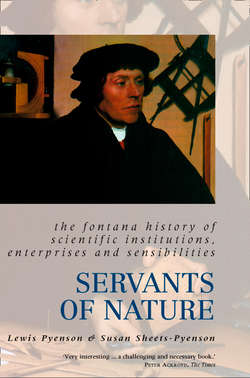Читать книгу Servants of Nature: A History of Scientific Institutions, Enterprises and Sensibilities - Lewis Pyenson - Страница 5
CONTENTS
ОглавлениеINTRODUCTION: Science and Its Past
The discipline of history of science
1 Teaching: Before the Scientific Revolution
2 Teaching: From the Time of the Scientific Revolution
The rise of the German university
The German research university in context
3 Sharing: Early Scientific Societies
Engines of the Scientific Revolution
The rise of the scientific correspondent
Nineteenth-century consolidation
The emergence of specialized societies
4 Watching: Observatories in the Middle East, China, Europe and America
Astronomy and related disciplines
The development of modern museums
The British Museum and the ‘new museum idea’
Museums in Europe and the United States
Colonial and metropolitan museums: some comparisons
Descriptions of colonial museums
Museums in Canada, South America, and Australasia
6 Growing: Botanical Gardens and Zoos
The development of botanical gardens
The evolution of zoological gardens
7 Measuring: The Search for Precision
Syncretism and measuring instruments
Measurement and industrial progress
Absolute measurement and error analysis
The transformation of mechanical precision
Precision and the human spirit
8 Reading: Books and the Spread of Ideas
Facilitating the birth of modern science
The rise of the scientific journal
Showing science: the art of illustration
9 Travelling: Discovery, Maps and Scientific Expeditions
Progression of people and ideas in the Malay Archipelago
Statistics physical and social
The popular triumph of averages
11 Killing: Science and the Military
The vocabulary of military science
12 Participating: Beyond Scientific Societies
The rise of literary and philosophical societies
Associations for the advancement of science
The overseas extension of European models
The example of Madame du Châtelet
13 Appropriating: Science in Nations Beyond Europe
The research university in the United States
Scientist missionaries in South America
Science at American universities
Science at Japanese universities
British India and Dutch Indonesia
14 Believing: Science and Religion
Science in the Counter-Reformation
The Webster thesis: millenarianism and science
The argument against Darwinian evolution
Twentieth-century developments
15 Knowing: Progressing and Proclaiming
The polemical positivism of Auguste Comte
The reception of Einstein’s thought
